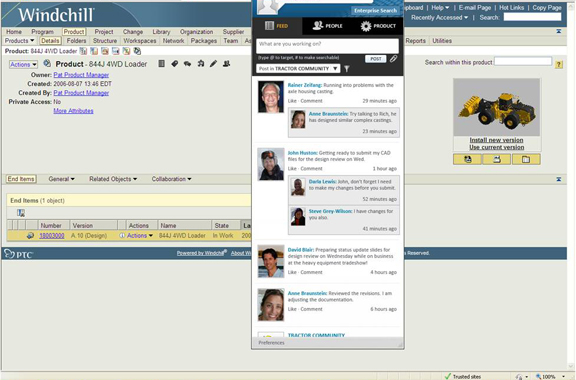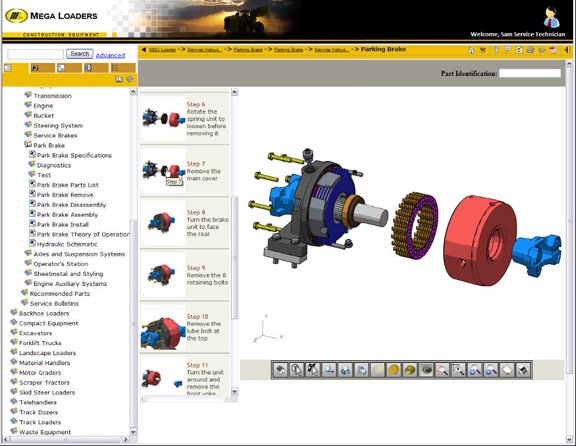June 9, 2010


What would a family of social media-inspired applets developed to run behind an enterprise firewall look like? It might look like PTC’s Windchill SocialLink, unveiled at PTC User World this year.
Running on Microsoft SharePoint, PTC’s Windchill SocialLink allows you to deploy functions similar to Twitter, Facebook, and Blogger. Robin Siatz, PTC’s senior VP of solutions marketing, explained, “There’s agreement in strategy across the company [PTC] that social product development services should be available to the whole product development system.”
Socialized Product Development
Last year, PTC launched a new product called Windchill ProductPoint, also based on Microsoft SharePoint. Whereas ProductPoint is meant as a product data vault, visualization, markup, and collaboration platform, SocialLink lets you tag content (as you would your photos in Flickr), communicate with colleagues and partners in short text blurbs (as you do on Twitter), find potential collaborators within your firm (as you might identify new friends on Facebook), and receive RSS feeds about your SocialLink associates’ activities.
SocialLink is a standalone package, but to derive its benefits fully, it should be deployed alongside other products like Windchill PDMLink, Siatz explained. Some SocialLink services (as these components are called) may appear as a toolbar in select PTC products, allowing you to engage with colleagues while you work.
“What’s missing in most companies is a sense of community, a shared birds-of-a-feather experience,” noted Brian Shepherd, PTC’s executive VP of product development. “SocialLink will allow these communities to form and flourish, allowing you to capture their collective wisdom.”
PTC plans to roll out SocialLink later this year. PTC’s PLM (product lifecycle management) rival Dassault Systemes is currently developing a similar enterprise-focused social-media platform, dubbed 3dswymer (in closed beta).
Service Manuals via Arbortext
Ever since it acquired document-composer Arbortext in 2007, PTC has been looking for ways to market its XML-based dynamic text formatting and publishing technology to PLM users. This year, PTC may have found the best approach—as a package for producing service manual and technical content.
The core component of this approach is the Arbortext Illustrator application, which lets you create animations and technical drawings. This will become part of PTC’s Arbortext service information solutions. The linkage between Windchill PDMLink and Arbortext ensures that when the source data (the original Pro/ENGINEER model) is modified, service publication managers receive alerts to update the technical content.
PTC’s rival Autodesk recently released a similar application, known as Autodesk Inventor Publisher. Another competitor, Dassault Systemes, also offers its own version, called 3DVIA Composer.
Subdividing SurfacesThough Pro/ENGINEER is primarily a parametric modeler catering mechanical engineers, those who must create free-form shapes and surfaces can employ the ISDX (interactive surface design extension) module to sculpt complex solids and surfaces. In Pro/ENGINEER Wildfire 6.0, a new subdivisional modeling module is set to become available.
Paul Sager, PTC’s director of product management for surfacing and industrial design, explained, “Subdivisional modeling is primarily used in animation, for sculpting faces. It exists in products like [Autodesk’s] 3ds Max or Maya.”
With the new module, by subdividing the control mesh (think of it as a wirecage enveloping your 3D model), you can drag, pinch, push, and pull on specific points to deform your model’s geometry. “What it creates is high-quality B-Spline surfaces,” said Sager. “It’s not going to be available till next year.”
The module is driven by technology developed in-house. Currently, it exists only as early Alpha code.
Recently, PTC debut a new version of CoCreate, the direct modeling package it acquired in 2007. Version 17 marks CoCreate’s reemergence under PTC’s guidance. At the same time, some of CoCreate’s modeling techniques may be finding their ways into PTC’s core parametric package Pro/ENGINEER.
CoCreate’s Copilot navigation tool (a compass-like directional icon that allows you to rotate, push, or pull edges and surfaces along axises and angles) is now poised to appear in Pro/E. The function is currently in the hands of beta testers, according to Sandy Joung, PTC’s director of product marketing for Pro/E and Mathcad.
For more, read “PTC User World 2010: Lightning to Reinvigorate CAD and PLM.”
To see captions of photos in the slide show below, hover your mouse over the image and click on the “i” icon.
Subscribe to our FREE magazine, FREE email newsletters or both!
About the Author
Kenneth Wong is Digital Engineering’s resident blogger and senior editor. Email him at [email protected] or share your thoughts on this article at digitaleng.news/facebook.
Follow DE





